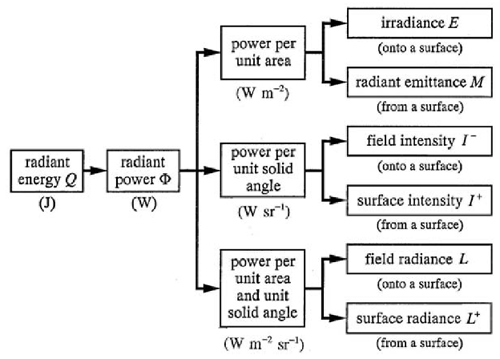Page updated:
October 23, 2020
Author: Curtis Mobley
View PDF
Historical Notation
As noted in Level 1, different fields of science have developed different terminology and notation for the same physical quantities. Tabel shows the ”historic” and ”modern” notations seen in oceanograpic literature. The recommended (modern) notation came into use the late 1970s and is employed, for example, in Jerlov (1976) and further refined in Morel and Smith (1982). The historic notation is generally found in works published before the late 1970’s, most notably in Preisendorfer’s 1977 opus magnum Hydrologic Optics.
| Quantity | SI Units | Recommended Symbol | Historic Symbol |
| radiant energy | |||
| radiant power | |||
| radiant intensity | |||
| radiance | |||
| plane irradiance | |||
| downward plane irradiance | |||
| upward plane irradiance | |||
| scalar irradiance | |||
| downward scalar irradiance | |||
| upward scalar irradiance | |||
| vector irradiance | |||
| vertical net irradiance | — | ||
| emittance | |||
| photosynthetically available radiation | or | — |
It is occasionally convenient to distinguish conceptually between photons leaving a surface and photons arriving at a surface. In radiative transfer theory, field radiance refers to the radiance of photons arriving at a surface; this is the quantity measured by a radiance meter. Surface radiance is the radiance attributed to a real or imaginary surface emitting photons. Irradiance refers to photons incident onto a surface; the corresponding measure of photons leaving a surface is denoted by radiant exitance or emittance . Likewise, intensity can be subdivided into field intensity and surface intensity . The figure summarizes this hierarchy of radiometric concepts.


 See comments posted for this page and leave your own.
See comments posted for this page and leave your own.